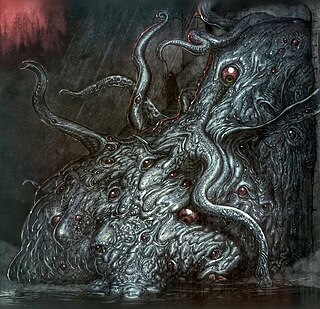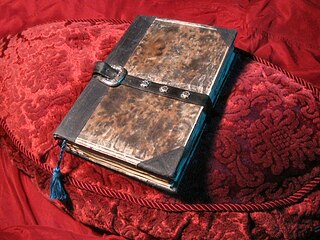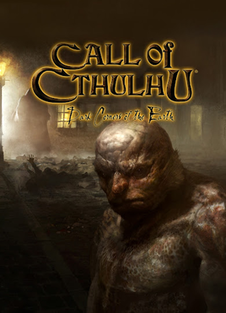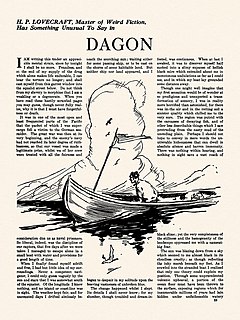
Call of Cthulhu is a horror fiction role-playing game based on H. P. Lovecraft's story of the same name and the associated Cthulhu Mythos. The game, often abbreviated as CoC, is published by Chaosium; it was first released in 1981 and is currently in its seventh edition, with many different versions released. It makes use of Chaosium's Basic Role-Playing (BRP) system, with special rules for Sanity.

Cthulhu is a fictional cosmic entity created by writer H. P. Lovecraft and first introduced in the short story "The Call of Cthulhu", published in the American pulp magazine Weird Tales in 1928. Considered a Great Old One within the pantheon of Lovecraftian cosmic entities, the creature has since been featured in numerous popular culture references. Lovecraft depicts it as a gigantic entity worshipped by cultists, in shape like an octopus, a dragon, and a caricature of human form. Its name was given to the Lovecraft-inspired universe where it and its fellow entities existed, the Cthulhu Mythos.
The Pnakotic Manuscripts is a fictional manuscript in the Cthulhu Mythos. The tome was created by H. P. Lovecraft and first appeared in his short story "Polaris" (1918). They are mentioned in many of Lovecraft's stories, including "The Other Gods" (1933), The Dream-Quest of Unknown Kadath (1926), The Whisperer in Darkness, At the Mountains of Madness (1936), "Through the Gates of the Silver Key", The Shadow Out of Time (1936) and "The Haunter of the Dark". The manuscripts are also referred to by other Mythos authors, such as Lin Carter and Brian Lumley.

Azathoth is a deity in the Cthulhu Mythos and Dream Cycle stories of writer H. P. Lovecraft and other authors. He is the ruler of the Outer Gods, and may be seen as a symbol for primordial chaos.

Tsathoggua is a supernatural entity in the Cthulhu Mythos shared fictional universe. He is the creation of American writer Clark Ashton Smith and is part of his Hyperborean cycle.

A shoggoth is a monster in the Cthulhu Mythos. The beings were mentioned in passing in H. P. Lovecraft's sonnet cycle Fungi from Yuggoth (1929–30) and later described in detail in his novella At the Mountains of Madness (1931).

The Elder Things are fictional extraterrestrials in the Cthulhu Mythos. The beings first appeared in H. P. Lovecraft's novella, At the Mountains of Madness, and later appeared, although not named, in the short story "The Dreams in the Witch-House" (1933). Additional references to the Elder Things appear in Lovecraft's short story "The Shadow Out of Time" (1936).

A flying polyp is a fictional, polyp-like extraterrestrial lifeform created by H. P. Lovecraft for the Cthulhu Mythos. Lovecraft introduced the creatures in his 1936 novella The Shadow out of Time. "Flying polyp" is a term of convenience, since Lovecraft never published a name for the creatures.
Call of Cthulhu: The Card Game is an out-of-print card game produced and marketed by Fantasy Flight Games. It is based on Chaosium's Call of Cthulhu role-playing game, the writings of H. P. Lovecraft, and other Cthulhu Mythos fiction. In 2008, Fantasy Flight moved the game over to its Living Card Game (LCG) format, which retains the deck-building aspect of collectible card games, but without the random distribution.

The Shadow over Innsmouth is a horror novella by American author H. P. Lovecraft, written in November–December 1931. It forms part of the Cthulhu Mythos, using its motif of a malign undersea civilization, and references several shared elements of the Mythos, including place-names, mythical creatures, and invocations. The Shadow over Innsmouth is the only Lovecraft story that was published in book form during his lifetime.

Many fictional works of arcane literature appear in H.P. Lovecraft's cycle of interconnected works often known as the Cthulhu Mythos. The main literary purpose of these works is to explain how characters within the tales come by occult or esoterica. However, in some cases the works themselves serve as an important plot device. Thus, in Robert Bloch's tale "The Shambler from the Stars", a weird fiction writer seals his doom by casting a spell from the arcane book De Vermis Mysteriis.

Lovecraftian horror is a subgenre of horror fiction that emphasizes the cosmic horror of the unknown more than gore or other elements of shock. It is named after American author H. P. Lovecraft (1890–1937). His work emphasizes a philosophy of cosmicism, the idea that the reality underlying the veneer of normality is so alien that seeing it would be harmful.

Call of Cthulhu: Dark Corners of the Earth is a survival horror video game developed by Headfirst Productions and published by Bethesda Softworks with 2K Games and Ubisoft for the Xbox and Microsoft Windows systems. The game was published for the Xbox in 2005 and Microsoft Windows in 2006. Call of Cthulhu: Dark Corners of the Earth combines an action-adventure game with a relatively realistic first-person shooter and elements of a stealth game.
The following characters appear in H.P. Lovecraft's story cycle — the Cthulhu Mythos.

The Shadow Out of Time is a novella by American horror fiction writer H. P. Lovecraft. Written between November 1934 and February 1935, it was first published in the June 1936 issue of Astounding Stories. The story describes time and space travel by mind transfer. The premise is that a person in a given place and time can switch bodies with someone who is elsewhere or elsewhen. Other writers have re-used this concept in later works, such as drinking tea from Red Forest leaves in the 12 Monkeys and long-range communication stones in the Stargate SG-1 television series. As with other Lovecraftian works, this story features blatantly alien beings that aren't simply variations on humans or other familiar terrestrial animals.

"Dagon" is a short story by American author H. P. Lovecraft. It was written in July 1917 and is one of the first stories that Lovecraft wrote as an adult. It was first published in the November 1919 edition of The Vagrant. Dagon was later published in Weird Tales. It is considered by many to be one of Lovecraft's most forward-looking stories.
The Deep Ones are creatures in the Cthulhu Mythos of H. P. Lovecraft. The beings first appeared in Lovecraft's novella The Shadow Over Innsmouth (1931), but were already hinted at in the early short story "Dagon". The Deep Ones are a race of intelligent ocean-dwelling creatures, approximately human-shaped but with a fishy appearance. They regularly mate with humans along the coast, creating societies of hybrids.
The Xothic legend cycle is a series of short stories by American writer Lin Carter that are based on the Cthulhu Mythos of H. P. Lovecraft, primarily on Lovecraft's stories "The Call of Cthulhu" and "Out of the Aeons".
"To Mars and Providence" is a short story by American writer Don Webb, published in War of the Worlds: Global Dispatches. It is a conflation of The War of the Worlds, the Cthulhu Mythos, and the biography of H. P. Lovecraft.
Serpent Men are a fictional race created by Robert E. Howard for his King Kull tales. They first appeared in "The Shadow Kingdom", published in Weird Tales in August 1929.












